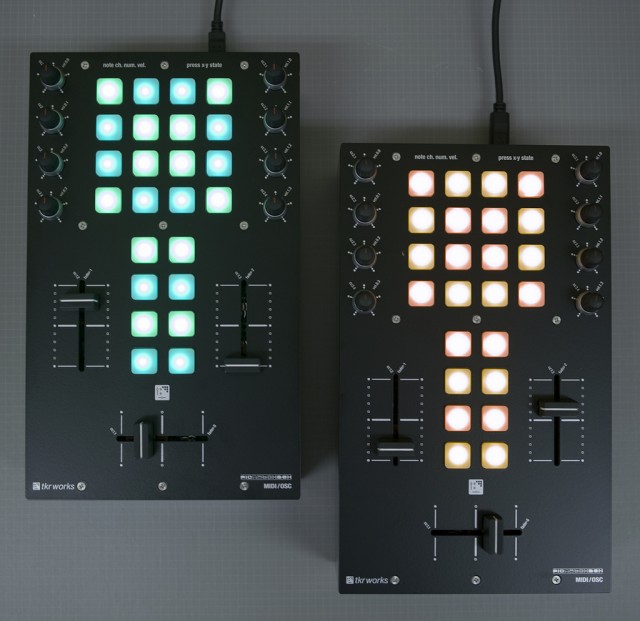It had to happen — button triggering, as popularized by the monome, here meets a conventional two-channel DJ mixer. But the layout I must say is quite spare and lovely, the work of the Japanese-based PICnome project. Furthermore, it’s Open Source Hardware, covered as I have recommended by a ShareAlike Creative Commons license (with no commercial restrictions) and GPL v3. (The creator prefers the term “Free Hardware,” which I love theoretically but have avoided for fear of people demanding we mail them MeeBlips by sending us a self-addressed, stamped box.)
With clean, subtle markings and a nicely-composed layout, it’s hardware that doesn’t scream out its design with big decals or overblown features. It’s just a (colored) grid controller, similar to the monome, combined with controller setup laid out as a two-channel mixer, with the sorts of features you’d expect of each. I love the angled labels, at least aesthetically. (I should note that this is not related to the monome project; the monome is not open source hardware, though it works via open software and commercially-restricted availability to some schematics. It is, of course, deserving of credit for inspiring a whole generation of hardware.)
The controller works with both OSC (OpenSoundControl) and MIDI for maximum flexibility. And, incidentally, this could be an ideal live visual controller, too, especially with that native OSC support.
Good grief; I realize I filled this post with nothing but technical jargon. Hopefully, those of you who speak in such tongue-twisted terms have followed along, and everyone else just looked at the pretty pictures and video.
Carry on.
PICratchBOX – Sneak Preview [atelier.tkrworks]
Japan, hope to come visit you some day soon. Thanks, Regend, for the tip!
Update: Read in comments about some lingering frustration that the original PICnome project was derived from the monome; since the monome doesn’t permit the sale of derivative designs, that could be viewed as an abuse of the available specifications for the monome. In this case, based on what I see, however, I’m hard pressed to see this product as being subject to the same criticism by virtue of having buttons, unless there’s some detail I’m missing. If I am missing something, please let me know.
By the way, if you want to revisit the PICnome project and decide for yourself, that thread is still on the monome community. It’s not accurate to say as some commenters do that the PICnome was a “bootleg” or simple clone of the monome, as it was re-implemented on a PIC chip. The issue is that the product was then made available for sale, because it was built on monome schematics; while those are readily available, they are not licensed for this kind of use. The firmware is free for use; it’s covered under a GPL license, which is non-revocable. However, to my knowledge, those same concerns may not necessarily apply to this project.
To recap: the PICnome project indeed is technically incompatible with the intentions and licensing of the monome project, but the new PICratchBox should be fine. So, here’s to the PICratchBox, which is more interesting precisely because it’s something new.
It is my view that the original PICnome project violated the terms of the licensing of the schematics; whether because of a misunderstanding or not, that’s not something to condone. But the new project does not do so, in my view. I contacted monome’s Brian Crabtree and while we didn’t have an on-the-record conversation, he took no issue with that statement.
